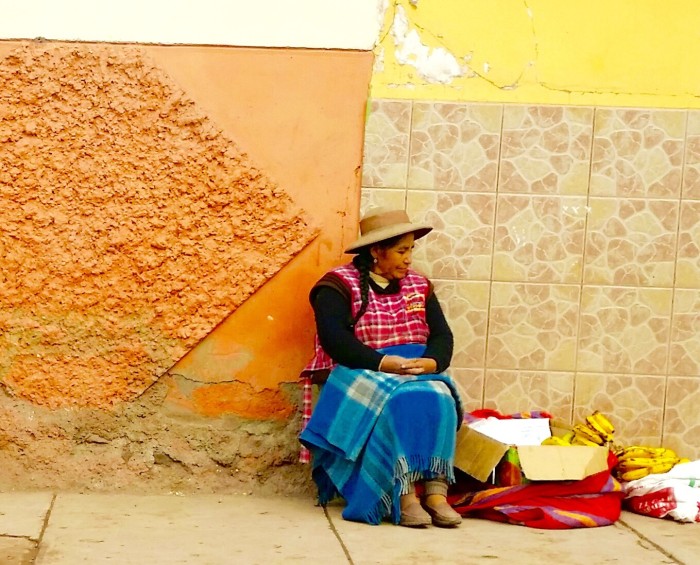There is a beautiful feeling of serenity at the spectacular former Incan city of Machu Picchu. The long road through the Andes to this remote paradise is not so well acclaimed, but is also very special. This is a journey unlike any you will ever have undertaken before, and it will stay with you forever. Getting to the jewel of the Sacred Valley can be costly and time consuming, but it is a journey which is to be enjoyed rather than endured. This is my 6-part travelogue, revealing the highlights of the road to Machu Picchu, including Chinchero.
Cusco to Ollantaytambo
The anticipation and excitement ahead of the onward journey to Machu Picchu is probably the only thing that softens the disappointment you feel when it is time to leave Cusco. The capital of the Andes has a strong magnetic lure, and leaves you wanting more. But it was time to leave, and head further north. Further into the Andes. And closer still to Machu Picchu.
The journey from Cusco to the wonderfully named Sacred Valley town of Ollantaytambo takes approximately 90 minutes. Although the city stands at over 11,500ft, and Machu Picchu is at a lower altitude, the road ascends further on the first section of the trip. This is because Ollantaytambo, and The Sacred Valley are on the other side of a vast upland plateau which must be traversed. From the centre of Cusco, the road corkscrews up through some of the city’s poorest neighborhoods, notably Los Huertos and Chanachayoc, where stereotypical South American shanty huts cling to the steep hillside.

Young woman in poorer district of northern Cusco, Peru

Selling bananas on the street at Los Huertos, Cusco, Peru

Woman in Chanachayoc District of Cusco, Peru
After tipping over the top of the mountain, the road then descends for several miles, before eventually flattening out as it crosses the magnificent Anta Plateau. This is home to some of Peru’s finest agricultural lands.
The town of Chinchero, at an altitude of 14,500 feet, is of particular interest, for it is here that a window into South America’s ancient past can be seen. The town’s 15,000 strong population, their language and culture, are almost entirely of Quechuan descent, which predates the Spanish conquistadors, and even the Incan empire. The townspeople can still be seen wearing traditional attire, and the area is noted for it’s self sufficiency and handmade arts and craft markets. There are also many Incan sites in the locality which are of great cultural significance.

The road through Chinchero district, near Cusco, Peru

Two ladies in traditional attire, waiting for a bus at Chinchero, near the city of Cusco in Peru.
Having lost a day on the trip due to being stuck in snow at high altitude en route from Arequipa, my tour guide had arranged for a taxi to take us on this journey as opposed to the tour bus as originally planned. As with many of the aspects of the trip, the contingency plan actually turned out to be a blessing in disguise, because we now had not only a driver, but a personal guide. The taxi driver, an amicable man called Aurturo, had great pride in his home region and was happy to discuss the points of interest along the route.
After telling me about all of the traditional culture in Chinchero, Aurturo then told me that the adjacent plateau is the site of a planned new international airport which will completely open up the area to yet more tourists. By 2025 people living near a major airport will be able to fly to within an hour of Machu Picchu and The Sacred Valley. We had a constructive debate about the merits of this development.

The agricultural plateau near Chinchero, soon to be home to Cusco International Airport
There is no doubt that the huge new international airport will bring more tourists to Machu Picchu, and create business opportunities for locals. But it will also dilute the ancient and unique ambience of Chinchero, filter people away from Cusco, put Machu Picchu itself under logistical strain and deprive visitors such as myself of seeing the beautiful panoramas on the more remote roads through the Andes.
Sill, progress is progress. Aurturo welcomed the news, but later admitted that this opinion was from a business perspective. He revealed that he may have plans to operate a private bus company to engage with the expected international tour operators. The airport project is being funded mostly by German and Brazilian venture capitalists. In truth, while progress is to be welcomed, I felt sad that Chinchero, one of the last fully authentic towns in the area, may soon be transformed in the name of globalization and mass tourism.

Arriving in The Sacred Valley, in the Andes Mountain range Peru en route to Machu Picchu
Having crossed the massive plateau, we finally came within sight of the Sacred Valley, and began the hair-raising descent through a series of corkscrews into Urubamba, the town which shares it’s name with the river which flows through the valley in the direction of Machu Picchu. The last leg of the trip, was to follow the river northwards for several miles to the small but bustling town of Ollantaytambo, where along with many other backpackers and tourists, we would take the iconic train journey to Aquas Calientes. By now, the excitement of approaching Machu Picchu was making it almost impossible to fully enjoy the surroundings along the route.
Have you read the other posts in this series?
Part 1: Arequipa
Part 2: Arequipa to Cusco
Part 3: Cusco
Part 5: Ollantaytambo to Aquas Calientes






